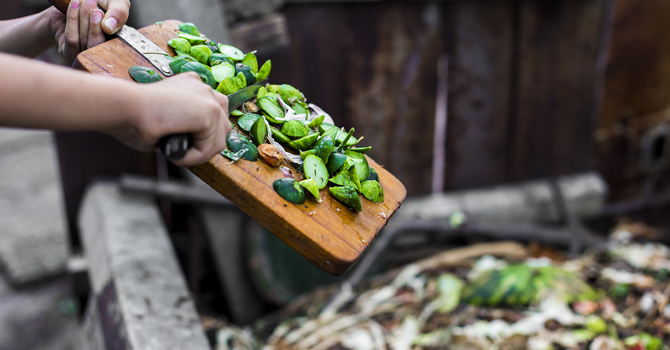Trash to Treasure: The Incredible Benefits of Composting

Pahriya Ashrap and Amber Cathey
PhD Students in Environmental Health Sciences
[Student Org Pursuit Takeover]
Students Creating the Conversation
Check out other articles by student org leaders on The Pursuit.
As a field at the forefront of environmental health, public health can take the lead in teaching and encouraging sustainable practices around our daily behaviors, including what we do with our waste products.
Especially for those overwhelmed by the idea of global climate change often seems futile, it is important to remember that small lifestyle changes can have large impacts. One place to start is with composting.
What is composting?
Composting is a natural process by which any organic material, such as food waste or lawn trimmings, is broken down by naturally occurring bacteria and fungus in the soil to form compost.1 The resulting materials—compost—is a nutrient-rich soil amendment that looks a lot like soil itself.
Composting can be successful in almost any setting, from indoor bins in condos or apartments, to outdoor piles in backyards, to office spaces where compostable material is collected and taken to an external composting facility.
How do I know what to compost?
The simplest answer is fruit and vegetable scraps, whether fresh, cooked, frozen, or completely moldy. Keep these treasures out of garbage disposals and landfills and compost them. Other good things to compost include tea (with the bag unless the bag is plastic), coffee grounds (including paper filters), plant prunings, leaves, and grass cuttings. Make sure to break yard waste into small pieces before throwing into a composting heap and avoid diseased leaves and plants as they may infect your compost.
A common misconception is that biodegradable and compostable mean the same thing.
Natural paper products are compostable, but glossy papers should be avoided as they can overwhelm your soil with chemicals that take longer to break down. Animal products like meat and dairy are compostable but often create foul odors and attract pests like rodents and insects. It is also best to leave these items out of your compost:
- animal waste—especially dog and cat feces (attracts unwanted pests and smells and may contain parasites)
- yard trimmings treated with chemical pesticides (may kill beneficial composting organisms)
- coal ashes (contain sulfur and iron in amounts high enough to damage plants)
- glass, plastics, and metals (recycle these!).
How do I compost?
Place items you want to compost together in a bin or pile with plenty of air flow. Keep your compost moist and, if it smells, add more leaves, brown paper, or grass clippings (the “browns”) to balance out the “greens”—the fruit and veggie scraps that are causing the stink as they break down. Keep adding browns and greens and, when the volume becomes difficult to manage, begin a new pile and let the old pile finish off (break down so that it is completely black and does not have large pieces of recognizable food waste) before adding it to soil.
Can things labeled biodegradable go into my compost?
A common misconception is that biodegradable and compostable mean the same thing. This is incorrect! Biodegradable means that a product will naturally break down over time, meaning any period of time. A certified compostable product contains a required amount of material that will break down within 180 days into pieces 2mm or less in size, and this process of breaking down cannot release harmful substances, such as heavy metals, into the soil.2
According to the Environmental Protection Agency (EPA), food scraps and yard waste make up about 30% of materials sent to landfills.3 Biodegradable products are less sustainable when they go in the trash. At a landfill, biodegradable materials decompose anaerobically—with little or no oxygen present—and release methane gas into the atmosphere. Methane is one of the more potent greenhouse gasses, so its presence in the atmosphere accelerates the process of global warming.4 Many landfills are designed to capture and use the methane for energy before it releases into the atmosphere, but it is much more efficient to keep biodegradable materials in compost piles or send them to composting facilities.
A little waste goes a long way.
Composting provides a host of benefits:
- Composting significantly cuts down on the amount of trash in a landfill and reduces the costs and carbon emissions it takes to haul and process those materials. Meanwhile, the valuable nutrients in your compostable materials make composting a favorable alternative to shipping your organic waste to a landfill.
- Composting enriches the soil with nutrients, which reduces the need for fertilizers and pesticides. Fertilizers and pesticides require fossil fuels for their production and shipping, and some of them are potentially harmful to our health.
- Compost increases soil’s ability to retain moisture, thus helping to prevent erosion
by reducing runoff. And compost prevents and suppresses plant diseases and pests.3 Moister, healthier soil improves the workability of the soil and reduces fossil fuel
emissions that would otherwise be needed to produce and ship soil-maintenance products.
Composting can help sequester carbon, meaning that composting can help remove carbon from the atmosphere.
Studies have shown that plants grow more rapidly in soil supplemented with compost, meaning they can pull more carbon dioxide out of the air. According to the EPA, the amount of carbon sequestered in soil and plants after wet compost is applied could significantly reduce greenhouse gasses if applied on a large scale.5
So start composting today. The best way to learn is to start doing it. Your soil and your planet will be so happy!
References
- “Compost FAQs,” Office of Campus Sustainability, University of Michigan.
- “What’s the Difference? Biodegradable and Compostable,” Nature’s Path (June 2018).
- “Benefits of Composting,” Composting at Home, EPA.
- “The Myths of Biodegradation,” Biodegradable Products Institute; Climate Change 2007: The Physical Science Basis, Intergovernmental Panel on Climate Change, Solomon et al., eds. (Cambridge University Press: Cambridge, 2007).
- Lou, X.F., J. Nair, “The Impact of Landfilling and Composting on Greenhouse Gas Emissions: A Review,” Bioresource Technology 100/16 (August 2009): 3792–98.
- Read more articles by Michigan Public Health students.
- Learn more about student advocacy work at Michigan Public Health.
- Support students at Michigan Public Health.
About the Authors
 Amber Cathey is a PhD student in Environmental Health Sciences studying the effects of phthalates and other
environmental exposures on birth outcomes in a Puerto Rican pregnancy cohort. She
is also interested in sustainability and leads the Public Health Sustainability Initiative student organization. She earned an MPH in Occupational and Environmental Epidemiology in 2017 and a BS in Cellular and Molecular
Biology and Evolutionary Anthropology in 2015, both from the University of Michigan.
Amber Cathey is a PhD student in Environmental Health Sciences studying the effects of phthalates and other
environmental exposures on birth outcomes in a Puerto Rican pregnancy cohort. She
is also interested in sustainability and leads the Public Health Sustainability Initiative student organization. She earned an MPH in Occupational and Environmental Epidemiology in 2017 and a BS in Cellular and Molecular
Biology and Evolutionary Anthropology in 2015, both from the University of Michigan.
 Pahriya Ashrap is a PhD student in the Environmental Health Sciences department studying the impact of environmental
exposures on maternal and children's health. As part of her dissertation, she is exploring
how environmental metal exposures during pregnancy are potentially associated with
preterm birth as well as providing information on the predictors and sources of exposure
among pregnant women in Puerto Rico. She earned an MS from Harvard University T.H. Chan School of Public Health and holds a BS from Peking
University College of Urban and Environmental Sciences.
Pahriya Ashrap is a PhD student in the Environmental Health Sciences department studying the impact of environmental
exposures on maternal and children's health. As part of her dissertation, she is exploring
how environmental metal exposures during pregnancy are potentially associated with
preterm birth as well as providing information on the predictors and sources of exposure
among pregnant women in Puerto Rico. She earned an MS from Harvard University T.H. Chan School of Public Health and holds a BS from Peking
University College of Urban and Environmental Sciences.
The Public Health Sustainability Initiative (PHSI) is a student-run organization committed to promoting sustainable practices at the School of Public Health. Our ongoing efforts include supplying small-scale zero-waste events with compostable materials, running a cap and gown reuse rental program, and hosting an annual Earth Day event where people can learn about composting and recycling and can bring unwanted clothing for a stuff-swap. Projects on the horizon include acquiring solar-powered work stations for the school, placing more compost bins throughout both buildings, and creating recycling stations for items such as batteries, electronics, and pens that are easily accessible to the community.
